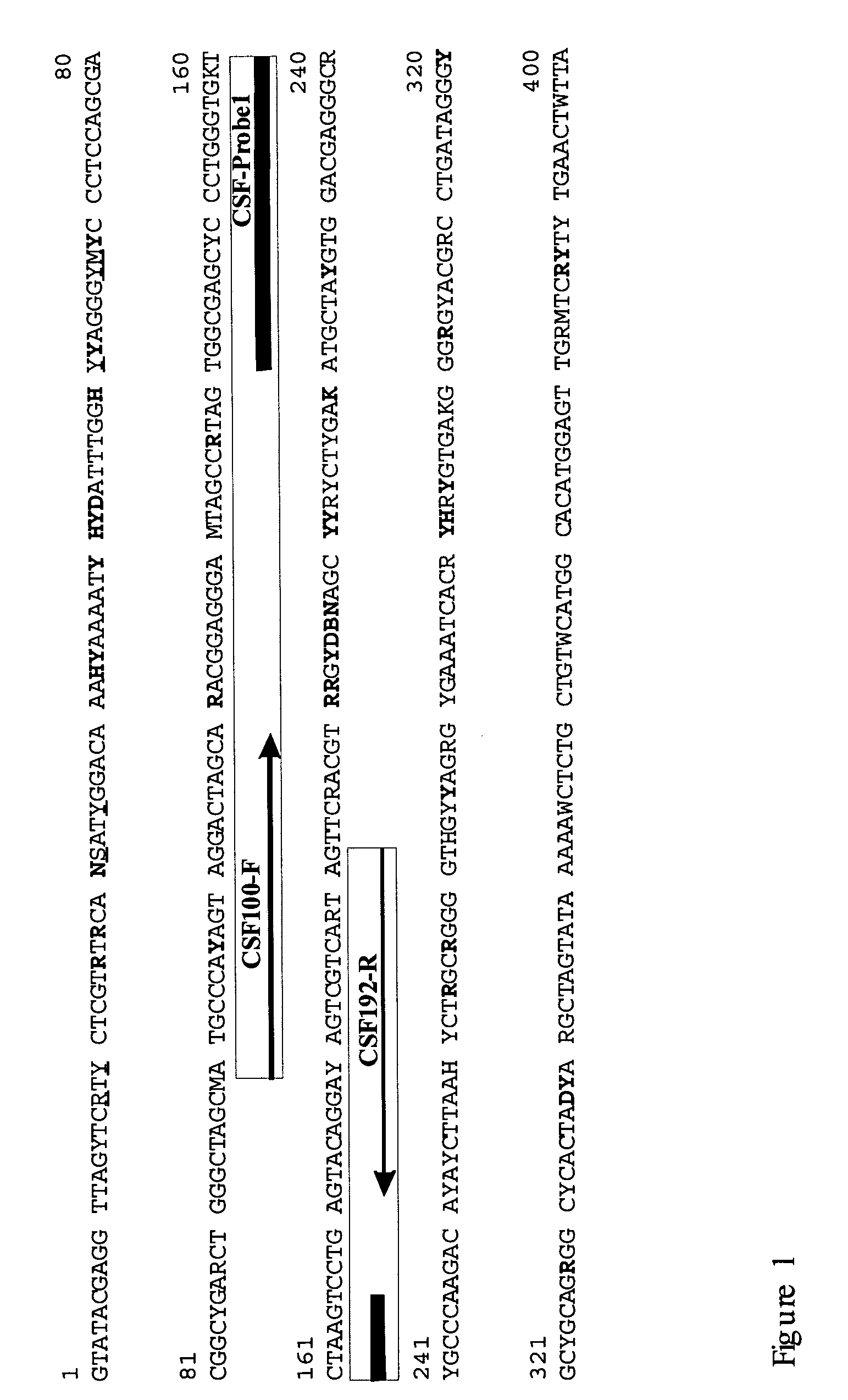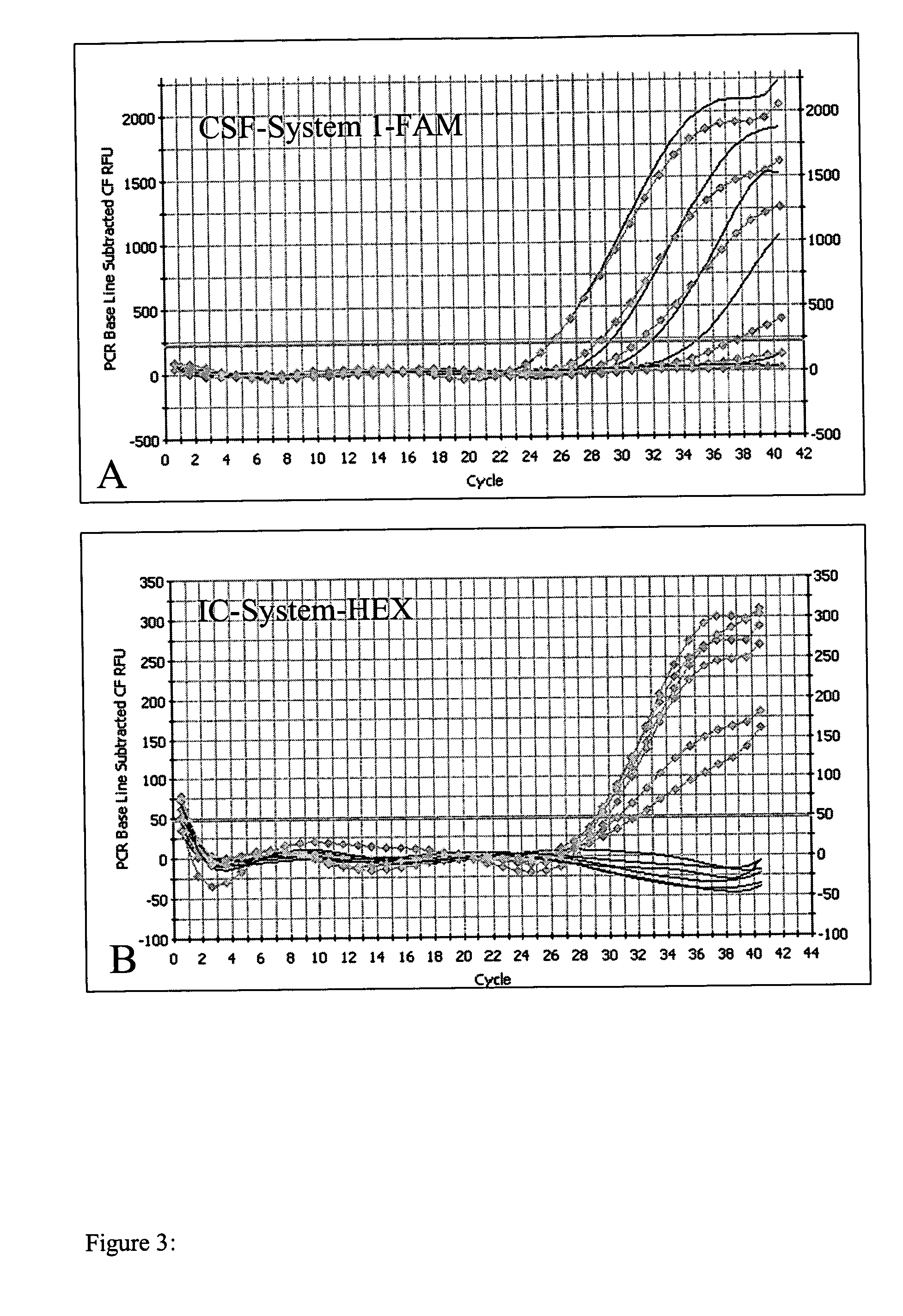Method of detection of classical swine fever
a detection method and swine fever technology, applied in the field of oligonucleotides, can solve the problems of csf continuing to cause serious problems, diagnostic problems, and the risk of cross-contamination of the detection of amplified pcr products by gel-based systems
- Summary
- Abstract
- Description
- Claims
- Application Information
AI Technical Summary
Benefits of technology
Problems solved by technology
Method used
Image
Examples
example 1
A. Example 1
Viruses and Cells
[0099] Viruses used in this study (9×BDV, 22× BVDV 1, 19× BVDV 2, 36× CSFV, atypical Pestivirus Giraffe (Avalos et al., 2001), atypical pestivirus D32 / 00 “HoBi”[Schirrmeier et al., 2004]) are listed within the virus bank of the National Reference Laboratory for CSF located at the Friedrich-Loeffler-Institut, Insel Riems (Germany). Some of the isolates were obtained from the Community Reference Laboratory for CSF (TiHo Hannover, Germany). All CSFV strains were cultured using porcine kidney cells (PK-15), whereas the BDV and BVDV were propagated using bovine kidney cells (MDBK), or sheep thymus cells (SFT-R). The cell lines were provided by the Collection of Cell Lines in Veterinary medicine (CCLV), Insel Riems (Germany).
example 2
B. Example 2
Virus Isolation Using Cell Culture
[0100] Cell cultures were inoculated with different dilutions of the virus strains, and incubated at 37° C. After 4 days, the monolayers of the cells were heat-fixed, and stained with the Pestivirus specific monoclonal antibody C16 (Peters et al., 1986). All virus isolations were performed in duplicate. CSFV titers were determined using log10 dilution steps in quadruplicate. Virus titers were calculated as tissue culture infectious dosage 50% (TCID50) per ml.
example 3
C. Example 3
RNA Isolation and Addition of an Internal Control
[0101] Viral RNA was extracted from cell culture using the QIAamp viral RNA kit (Qiagen) according to the manufacturers instructions, modified by addition of the internal control (IC) RNA. Briefly, 140 μl cell culture supernatant was added to 560 μl lysis buffer, vortexed and incubated at room temperature for 5 min. Subsequently, 5 μl in vitro transcribed IC RNA (2×105 copies / μl) was added. After 5 min, 560 μl of ethanol was added and the solution was centrifuged through a QIAamp spin column. After washing the column twice with the appropriate buffer, the RNA was eluted using 50 μl elution buffer, and stored at −20° C.
PUM
| Property | Measurement | Unit |
|---|---|---|
| Time | aaaaa | aaaaa |
| Volume | aaaaa | aaaaa |
| Sensitivity | aaaaa | aaaaa |
Abstract
Description
Claims
Application Information
 Login to View More
Login to View More - R&D
- Intellectual Property
- Life Sciences
- Materials
- Tech Scout
- Unparalleled Data Quality
- Higher Quality Content
- 60% Fewer Hallucinations
Browse by: Latest US Patents, China's latest patents, Technical Efficacy Thesaurus, Application Domain, Technology Topic, Popular Technical Reports.
© 2025 PatSnap. All rights reserved.Legal|Privacy policy|Modern Slavery Act Transparency Statement|Sitemap|About US| Contact US: help@patsnap.com



